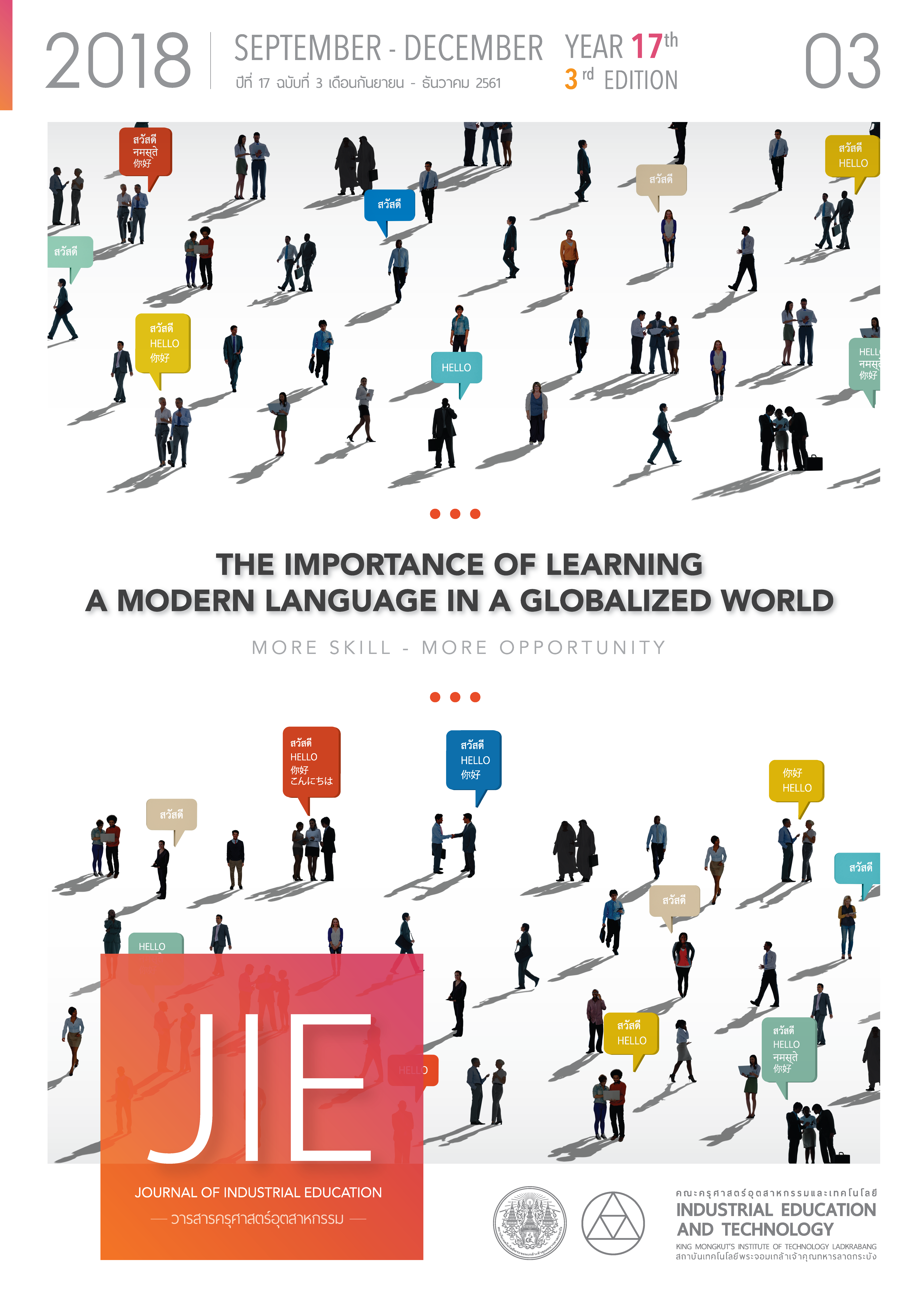การพัฒนาบทเรียนอีเลิร์นนิงตามแนวทฤษฎีคอนสตรัคติวิสต์ เรื่องภาษาอังกฤษเพื่อการสื่อสาร สำหรับนักเรียนชั้นประถมศึกษาปีที่ 5
คำสำคัญ:
บทเรียนอีเลิร์นนิงตามแนวทฤษฎีคอนสตรัคติวิสต์, ภาษาอังกฤษเพื่อการสื่อสาร, คุณภาพบทเรียน, อีเลิร์นนิง, ประสิทธิภาพ, บทเรียนอีเลิร์นนิ่ง, ผลสัมฤทธิ์ทางการเรียนบทคัดย่อ
การวิจัยครั้งนี้มีวัตถุประสงค์เพื่อ 1.) พัฒนาหาคุณภาพและประสิทธิภาพของบทเรียนอีเลิร์นนิงตามแนวทฤษฎีคอนสตรัคติวิสต์ 2.) เปรียบเทียบผลสัมฤทธิ์ทางการเรียนของนักเรียนที่เรียนด้วยบทเรียนอีเลิร์นนิงตามแนวทฤษฎีคอนสตรัคติวิสต์ เรื่องภาษาอังกฤษเพื่อการสื่อสาร กับนักเรียนที่เรียนโดยวิธีการสอนแบบปกติ กลุ่มตัวอย่างในการวิจัย คือ นักเรียนชั้นประถมศึกษาปีที่ 5 โรงเรียนอนุบาลวังม่วง เขตพื้นที่การศึกษาเขต 2 จังหวัดสระบุรี จำนวน 90 คน ซึ่งได้จากการสุ่มตัวอย่างแบบกลุ่ม (Cluster Random Sampling) จำนวน 3 กลุ่ม เครื่องมือที่ใช้ในการวิจัยครั้งนี้ ประกอบด้วย บทเรียนอีเลิร์นนิงตามแนวทฤษฎีคอนสตรัคติวิส์ เรื่องภาษาอังกฤษเพื่อการสื่อสาร แบบประเมินคุณภาพบทเรียนบทเรียนอีเลิร์นนิง แบบประเมินทักษะการพูด แบบทดสอบวัดทักษะจากฟังบทสนทนาจากแถบบันทึกเสียง และแบบทดสอบวัดผลสัมฤทธิ์ทางการเรียน เรื่องภาษาอังกฤษเพื่อการสื่อสาร จำนวน 30 ข้อ ที่มีค่าความตรงเชิงเนื้อหา (IOC) ระหว่าง 0.67 – 1.00 มีค่าความยากง่าย (p) ระหว่าง 0.33 – 0.63 ค่าอำนาจจำแนก (r) ระหว่าง 0.20 – 0.53 ค่าความเชื่อถือได้ เท่ากับ 0.79 สถิติที่ใช้ในการวิเคราะห์ข้อมูล ได้แก่ ค่าเฉลี่ย () ค่าเบี่ยงเบนมาตรฐาน (S.D.) และใช้การทดสอบค่าทางสถิติ t-test for independent semples ผลการวิจัยพบว่า บทเรียนอีเลิร์นนิงตามแนวทฤษฎีคอนสตรัคติวิส์ เรื่องภาษาอังกฤษเพื่อการสื่อสารมีคุณภาพด้านเนื้อหาอยู่ในระดับดีมาก (
= 4.67, S.D. = 0.45) คุณภาพด้านสื่อบนเครือข่ายอยู่ในระดับดีมาก (
= 4.52, S.D. = 0.49) และคุณภาพด้านการออกแบบบทเรียนบนเครือข่ายตามแนวทฤษฎีคอนสตรัคติวิสต์อยู่ในระดับดีมาก (
= 4.60, S.D. = 0.58) บทเรียนมีประสิทธิภาพของกระบวนการต่อประสิทธิภาพผลลัพธ์ (E1: E2) เท่ากับ 80.11 : 81.33 ซึ่งสอดคล้องกับเกณฑ์กำหนด และนักเรียนที่เรียนด้วยบทเรียนอีเลิร์นนิงตามแนวทฤษฎีคอนสตรัคติวิสต์ เรื่องภาษาอังกฤษเพื่อการสื่อสาร มีผลสัมฤทธิ์ทางการเรียนสูงกว่านักเรียนที่เรียนด้วยวิธีการสอนแบบปกติ อย่างมีนัยสำคัญทางสถิติที่ระดับ .05
เอกสารอ้างอิง
[2] Department of Curriculum and Instruction Development. 2012. Research on the development and use of computers for teaching : a case of elementary schools. Bangkok : Kurusapa Printing Press.
[3] Siengtip Sukhsri and Phongsri Lekhawattana 2003. How to use the internet in ELT Bangkok : Pearson Educdtion Indochina LTD, 2003)
[4] Jintavee khlasang. 2013. E-Learning Courseware. Bangkok : V Print(1991).
[5] Uthumporn Sansri. 2009. Construction of E-Learning Courseware on Venous Disease for Fourth Year Medical Students. Faculty of Medicine, Chiang Mai University Master degree of Science Program in Educational Technology, Chiang Mai University.
[6] Sumalee Chaijaroen 2011. Educational Technology : Principles Theories to Practices. Khonkaen : Klangnanavittaya Press.
[7] Seels, B., and Glassgow Z. 1998. Making Instrutional Design Decision Second Edition: Upper Saddle River NJ: Prentice – hall
[8] Anucha Somabut. 2013. 241208 Innovation and Educational Technology in Education. Khonkaen : Educational Technology Faculty of Education, Khon Kaen University.
[9] Chaiyong Brahmawong. 2013. Developmental Testing of Media and Instructional. Silpakorn Educational Research Journal, 5(1), p. 7-19.
ดาวน์โหลด
เผยแพร่แล้ว
รูปแบบการอ้างอิง
ฉบับ
ประเภทบทความ
สัญญาอนุญาต
"ข้อคิดเห็น เนื้อหา รวมทั้งการใช้ภาษาในบทความถือเป็นความรับผิดชอบของผู้เขียน"



